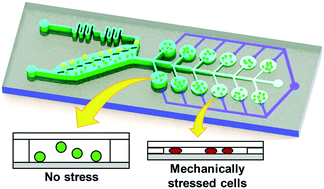Our official English website, www.x-mol.net, welcomes your feedback! (Note: you will need to create a separate account there.)
Mechanical stress induced astaxanthin accumulation of H. pluvialis on a chip.
Lab on a Chip ( IF 6.1 ) Pub Date : 2020-01-13 , DOI: 10.1039/c9lc01030k Junyi Yao 1 , Hyun Soo Kim 2 , Jee Young Kim 3 , Yoon-E Choi 3 , Jaewon Park 1
Lab on a Chip ( IF 6.1 ) Pub Date : 2020-01-13 , DOI: 10.1039/c9lc01030k Junyi Yao 1 , Hyun Soo Kim 2 , Jee Young Kim 3 , Yoon-E Choi 3 , Jaewon Park 1
Affiliation

|
Microalgae have been envisioned as a source of food, feed, health nutraceuticals, and cosmetics. Among various microalgae, Haematococcus pluvialis (H. pluvialis) is known to be the richest feedstock of natural astaxanthin. Astaxanthin is a highly effective antioxidation material and is being widely used in aquaculture, nutraceuticals, pharmacology, and feed industries. Here, we present a microfluidic chip consisting of a micropillar array and six sets of culture chambers, which enables sorting of motile flagellated vegetative stage H. pluvialis (15-20 μm) from cyst stage H. pluvialis as well as culture of the selected cells under a mechanically stressed microenvironment. The micropillar array successfully sorted only the motile early vegetative stage cells (avg. size = 19.8 ± 1.6 μm), where these sorted cells were uniformly loaded inside each culture chamber (229 ± 39 cells per chamber). The mechanical stress level applied to the cells was controlled by designing the culture chambers with different heights (5-70 μm). Raman analysis results revealed that the mechanical stress indeed induced the accumulation of astaxanthin in H. pluvialis. Also, the most effective chamber height enhancing the astaxanthin accumulation (i.e., 15 μm) was successfully screened using the developed chip. Approximately 9 times more astaxanthin accumulation was detected after 7 days of culture compared to the no mechanical stress condition. The results clearly demonstrate the capability of the developed chip to investigate bioactive metabolite accumulation of microalgae induced by mechanical stress, where the amount was quantitatively analyzed in a label-free manner. We believe that the developed chip has great potential for studying the effects of mechanical stress on not only H. pluvialis but also various microalgal species in general.
中文翻译:

机械应力导致片上H. pluvialis的虾青素积累。
微藻已被设想为食物,饲料,保健食品和化妆品的来源。在各种微藻中,已知嗜血红球菌(H. pluvialis)是天然虾青素最丰富的原料。虾青素是一种高效的抗氧化材料,被广泛用于水产养殖,营养保健品,药理学和饲料工业。在这里,我们介绍了一种由微柱阵列和六组培养室组成的微流控芯片,该芯片能够对囊状阶段的湿润鞭毛营养期H. pluvialis(15-20μm)进行分选,并对选定的细胞进行培养在受到机械应力的微环境下。微柱阵列仅成功地筛选了运动早期营养细胞(平均大小= 19.8±1.6μm),这些分类的细胞均匀地装入每个培养室内(每个培养室229±39个细胞)。通过设计具有不同高度(5-70μm)的培养室来控制施加到细胞的机械应力水平。拉曼分析结果表明,机械应力确实导致了虾青素在雨水螺旋藻中的积累。另外,使用开发的芯片成功筛选了增强虾青素积累的最有效腔室高度(即15μm)。与无机械应力条件相比,培养7天后检测到的虾青素积累量大约高出9倍。结果清楚地证明了开发的芯片具有研究机械应力引起的微藻生物活性代谢物积聚的能力,其中以无标签方式定量分析了该量。我们认为,开发的芯片具有巨大的潜力,不仅可以研究机械应力对幽门螺杆菌的影响,而且还可以研究一般的各种微藻种类。
更新日期:2020-02-13
中文翻译:

机械应力导致片上H. pluvialis的虾青素积累。
微藻已被设想为食物,饲料,保健食品和化妆品的来源。在各种微藻中,已知嗜血红球菌(H. pluvialis)是天然虾青素最丰富的原料。虾青素是一种高效的抗氧化材料,被广泛用于水产养殖,营养保健品,药理学和饲料工业。在这里,我们介绍了一种由微柱阵列和六组培养室组成的微流控芯片,该芯片能够对囊状阶段的湿润鞭毛营养期H. pluvialis(15-20μm)进行分选,并对选定的细胞进行培养在受到机械应力的微环境下。微柱阵列仅成功地筛选了运动早期营养细胞(平均大小= 19.8±1.6μm),这些分类的细胞均匀地装入每个培养室内(每个培养室229±39个细胞)。通过设计具有不同高度(5-70μm)的培养室来控制施加到细胞的机械应力水平。拉曼分析结果表明,机械应力确实导致了虾青素在雨水螺旋藻中的积累。另外,使用开发的芯片成功筛选了增强虾青素积累的最有效腔室高度(即15μm)。与无机械应力条件相比,培养7天后检测到的虾青素积累量大约高出9倍。结果清楚地证明了开发的芯片具有研究机械应力引起的微藻生物活性代谢物积聚的能力,其中以无标签方式定量分析了该量。我们认为,开发的芯片具有巨大的潜力,不仅可以研究机械应力对幽门螺杆菌的影响,而且还可以研究一般的各种微藻种类。

























 京公网安备 11010802027423号
京公网安备 11010802027423号